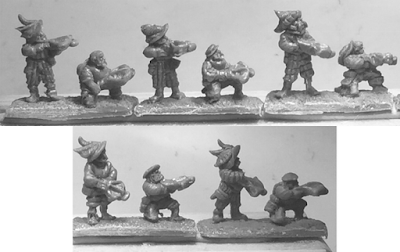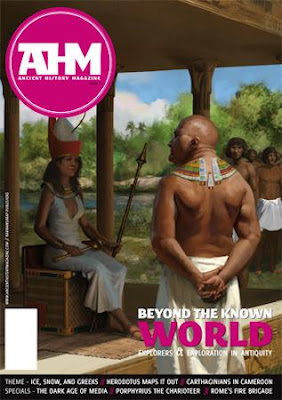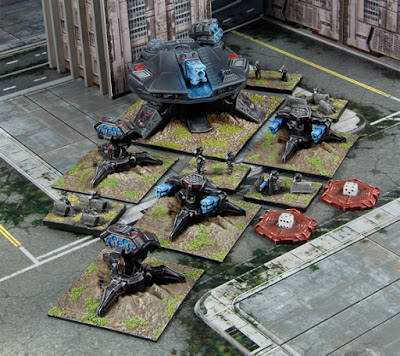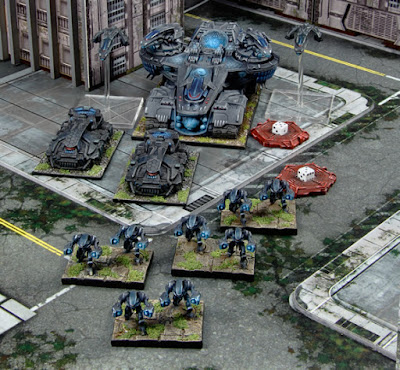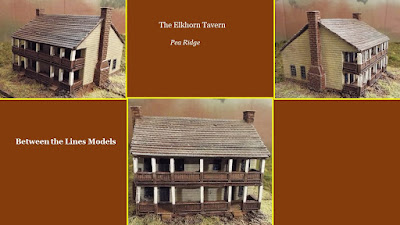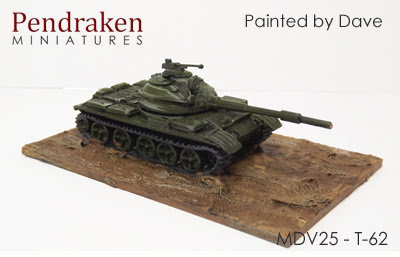These rules are free to download here in PDF format. You can send any feedback or questions to sotek486@yahoo.com I think they are fairly straight forward and combine elements of other systems that I've enjoyed over the years. Black Powder (generic unit concepts), Bolt Action (orders dice) and Kings Of War (morale) has been particularly inspiring.
Nov 30, 2015
Nov 26, 2015
Warmonger Miniatures, Release Crossbowmen
Warmonger Miniatures, Release Crossbowmen (German Landsknecht Armbrustschützen) Landsknechte Doppelsöldner armed with crossbows would lay ranged fire support by the flanks of the pike squares.
This is a Armbrustschützen (Crossbowmen) unit of fifteen strips of two figures each (30 figures total). You will receive fifteen rank and file strips (a mix of ls04a–e). Bases are not included.
Sculpted by Bob Naismith and cast by D & D Model Cleaning & Casting in lead free pewter.
Nov 24, 2015
Ancient History Magazine 1, 24 November 2015
Ancient History Magazine 1
Explorers and exploration in antiquity
Theme: Jona Lendering, "All lands covered by the sun - Exploring the World"
One of the greatest advances of the twentieth century is more widespread education, which has allowed everyone to have some sort of concept of what the world looks like. People may not all be able to locate this country or that city, but they recognize the outlines. In Antiquity, even the number of continents was unknown. Still, advances were made. Brave voyagers explored the oceans and deserts.
Theme: Edwin de Vries, "Explorer extraordinaire - Eudoxus of Cyzicus"
The Mediterranean Sea is an inland sea, surrounded by land: Europe to the north, Asia to the east, and Africa to the south. Beyond the Mediterranean, past the Pillars of Heracles (Strait of Gibraltar) lay the open sea or “Ocean”. Few Greeks and Romans had ventured beyond the Mediterranean. One those rare explorers was Eudoxus of Cyzicus.
Theme: Joseph Hall, "Voyage to the Frozen North - Pytheas of Mass alia"
On the shore of southern Gaul, protected from Gallic tribes of the hinterland by a rocky arc of mountains, rests the city of Massalia. From this idyllic coastal enclave Massaliotes had ventured upon the seas since the founding of the city itself. In the fourth century BC however, one citizen, Pytheas, set out upon a grueling and dangerous voyage. His intentions: to explore the frozen north, to find the Tin Isles, and to discover just what lay within the icy fog beyond the edge of the known world.
Theme: Owen Rees, "The world view of Herodotus - Mapping it out"
Although Herodotus is known as “Father of History”, the scope of his work is wider than the past only. The Histories also contain digressions on subjects as varied as ethnography, religion, and geography.
Theme: Judith Weingarten, "Queen Hatshepsut’s expedition south - Journeying to the land of Punt"
The ancient Egyptians used myrrh to embalm the bodies of their rulers. Demand was insatiable and it comes as no surprise that Hatshepsut, Egypt’s famous female king, sent out an expedition to the land fr om which it originated.
Theme: Sidney E. Dean, "Romans Seek the Nile's Headwaters - How Low Did They Go?"
Rome never attempted to settle or conquer Africa south of the Sahara, but did conduct exploratory missions in that direction. The most famous single expedition was ordered by Nero and conducted in AD 61-62. According to one controversial theory, that expedition might have reached as far south as Lake Albert, near the actual headwaters of the Nile at Lake Victoria.
Theme: Murray Dahm, "The Circumnavigation of Africa and more - Hanno’s Periplus"
Homer’s Odyssey may be the quintessential text about travel to unexplored, strange countries, but it certainly isn’t the only one. The Periplus of the Carthaginian sailor Hanno is another example: gorillas, savage men, wild animals, and volcanic eruptions, this short text has them all.
Theme: Jona Lendering, "Exploring the Incense Route - All the perfumes of Arabia"
Shakespeare knew his classics. When Lady Macbeth mentions “all the perfumes of Arabia”, she is referring to an age-old belief that the Arabian Peninsula was a place full of sweet smells. One of these was frankincense, which was transported from modern Oman to Gaza and Alexandria, and from there to the entire Roman world, where it was ostentatiously burnt in public ceremonies.
Special: Daan Nijssen, "Iran on the eve of Cyrus’s conquests - The Median Dark Age"
The swift rise of the Achaemenid Empire is one of the most intriguing phenomena in Antiquity. Within decades, this new world power united most of the known world into one empire. Unfortunately, the prehistory of this empire is still poorly understood. Classical Greek sources state that the Persian Empire was preceded by a Median Empire, but no hard evidence for such an empire has yet been found. The “Median period” may thus well be called the “Median Dark Age”. This article offers a reconstruction of this Median Dark Age and reassesses the role of the Medes in the prehistory of the Achaemenid Empire.
Special: Lucas Petit, "A much contested near eastern object - Authentic or fake?"
It is the nightmare of every collector: the object you bought turns out to be a forgery. Small surprise, therefore, that establishing the authenticity of ancient artifacts has become an important field of research. Occasionally, there is good news.
Special: Mark McCaffery, "The Vigiles of Augustan Rome - Protecting the Neighborhoods"
In the year AD 6, Augustus established the corps of vigiles in Rome. Officially tasked with both the prevention and fighting of fires, they also established closer links between the plebs urbana and the princeps. Later, they would also assume policing duties and have a significant role to play in key moments throughout Roman history.
Special: Richard Kroes, "An archaeologist reads a gospel - Smashing bottles"
It’s perhaps not the most famous story from the Bible, but it’s still quite significant: how a woman came to Jesus, broke an alabaster jar with perfume, and anointed the Messiah. The problem is that to break an alabaster jar, you need a sledge hammer. That begs the question: just what is going on in this story?
A member of the White's chariot teamSpecial: Nicola Bergamo, "Byzantium’s most famous charioteer - Porphyrius the Charioteer"
Porphyrius was without question the most important charioteer of the Byzantine era. He reigned supreme on the track for both the Greens and the Blues, so the two factions dedicated seven statues to him, all of which were installed on the middle barrier of Constantinople’s hippodrome. This is his story.
Special: Christian Koepfer, "Bringing wine to the frontiers - The tombstone of Publius Tenatius"
On 24 February 1981, the operator of a digger, working on a new boardwalk in Passau (Bavaria), was astonished when he pulled out of the Inn River a huge block of marble with an inscription and relief decoration. The find was made only two hundred meters west of the point where the Danube and Inn Rivers meet. Examination of the block revealed it to be the tombstone of one Publius Tenatius Essimnus.
On the cover: Arianna Sacco, "An Egyptian Queen of the Nile - An audience with HatShepsut"
The cover illustration of this first issue of Ancient History Magazine is inspired by a relief from Hatshepsut’s mortuary temple at Deir el- Bahri. The Queen gives a speech to the crowd, including the officers that led an expedition to Punt. In the relief, Hatshepsut is actually portrayed as a man, but for the cover it was decided to go beyond Egyptian iconographic conventions and represent her as a woman.
How do they know?: Jona Lendering, "How do we know if - A papyrus is genuine?"
Often, we read about spectacular, recently discovered papyri. Two years ago, there was a fragment in which Jesus was presented as speaking to “my wife”. Not much later, there were fragments by Sappho. Next, we learned about an incredibly old fragment from the Gospel of Mark. But how do scholars know those texts are genuine?
Ancient History Magazine
Ancient Warfare IX.5, Dec-Jan 2016
Warriors of the Hellenistic Age
Theme: Paul Johstono, "At the point of the sarissa - Historical Introduction"
When Alexander fell ill at Babylon, he was lord of a massive but fragile empire and commander of a large, experienced army, but lacked a ready heir. On his deathbed, the warrior king was reported to have said that his empire should pass “to the strongest” (Arrian 7.26.3, Diodorus 17.117.4), anticipating the violent struggle for power that consumed subsequent decades.
The Source: Michael J. Taylor, "The Macedonian Conscription Diagramma - Boys and old men"
Macedonia’s position as a Hellenistic power rested on its ability to mobilize large national armies of tough Macedonian peasants. Indeed, it was only when Philip II began to muster a mass infantry army that Macedon was transformed from a weak and venal state into a major international player. The Antigonid dynasty (277–168 BC) inherited Philip and Alexander’s military organization and recruitment patterns. Yet by the early second century BC, the Macedonian king desperately needed to raise troops to counter a new threat: Rome.
Theme: Manousos E. Kambouris, "One identity, three units, and many functions - The hypaspist corps"
The elite hypaspist corps was a special unit, inherited by Alexander along with the other components of the Macedonian army. The importance of these troops, not only during the great battles of Philip and Alexander, has ignited the interest and curiosity of many scholars.
Theme: Andrew Hillen, "The rise and fall of the Achaean League - Citizen soldiers in the Hellenistic age"
The army of the Achaean League contrasts sharply with the royal armies that appeared after the death of Alexander. More than anything, the Achaeans represent the continued evolution of Classical citizen soldiers. In the war-riven world of Hellenistic kings, the League’s citizen soldiers struggled to defend themselves with whatever strength they had. Though poorly matched against other standing armies of the time, these soldiers’ efforts helped to birth a new type of Greek community.
Theme: Haggai Olshanetsky, "Jewish soldiers in Hellenistic armies - warriors of Zion"
Jewish service in armies of antiquity remains a matter rarely discussed, especially the case of armed service under Hellenistic rule. One of the reasons for the silence engulfing this issue, is due to the manner in which the Jews tend to remember the Seleucid Empire, one of the major kingdoms of the Hellenistic period. The Jews celebrate annually the Chanukah in commemoration of their victory over the Seleucids and the achievement of independence in the second century BC.
The reenactor: Kurt Schrauder, "A Late Hellenistic Macedonian officer - Splendid and glorious"
During the Cleomenean War (228–222 BC), Macedon under King Antigonus III. joined a coalition with the Achaean League against Sparta, which tried to restore its former hegemony over Greece for one last time. While the actual fighting was confined to the Peloponnesian peninsula it took several years until the coalition could claim victory. In 222 BC, the joined forces of the Achaean League and the kingdom of Macedonia marched into the homeland of their Laconian foes and achieved a decisive victory at Sellasia .
Theme: Sidney E. Dean, "The fight for Alexander’s Asia - The Battle of Paraetacene"
The Battle of Paraetacene (or Paraitakene) was part of the greater power struggle among the Macedonian generals after Alexander the Great’s death in 323 BC. Perdiccas initially became regent for Alexander’s heirs, his mentally ill brother Philip III and Alexander’s infant son Alexander IV . When Perdiccas attempted to marry Alexander’s sister and thereby reach for the crown himself, several rival generals led by Antipater rebelled (322 BC). Alexander’s secretary Eumenes, now satrap of Cappadocia and Paphlonia, supported Perdiccas. This conflict, known as the First Diadochi War, ended with Perdiccas’ death in May 320 BC and Antipater’s rise to regent. The victors condemned Eumenes to death.
Theme: Marc G. DeSantis, "The Silver Shields after Alexander - Old Men's War"
Alexander’s hypaspistai (shield-bearers) performed a crucial role in Alexander’s great set-piece battles of the Granicus River, Issus, and Gaugamela. Since the hypaspists were relied upon to maintain the Macedonian battle line as it attenuated, they probably carried equipment more suited for open-order combat, such as the 7–8 foot long dory, and the large hoplite shield, than was employed by the ordinary phalanx rankers, who wielded the lengthier, two-handed sarissa pike. The hypaspists most likely gained the regimental moniker Argyraspides, or ‘Silver Shields’, at the start of the Indian campaign in 327 BC.
Theme: Robert Holmes, "Defection and the Hellenistic soldier - To the strongest"
During the Hellenistic period entire units and common soldiers routinely defected to the enemy, and were incorporated into the opposing army. Hellenistic soldiers might choose to defect prior to a battle, or even in the midst of one. On many occasions captured soldiers were taken into the army en masse after a battle. Defection to an opposing army was a regular part of the Hellenistic soldiers’ experience, and was encouraged by the nature of Hellenistic warfare.
Special: Brian Burfield, "Disease and the Roman army - fighting The hidden enemy"
Our image of the Roman soldier is usually that of a strong, robust individual ready for work and for battle. Rarely, however, do we imagine a gaunt-faced legionnaire who awakes one morning from a feverish and fitful sleep with a tongue so swollen and dry that he is unable to speak. With disease having made him too weak to walk on his own, he has to be helped to the latrines. Having become too feeble to even stay upright on the wooden seat he soon collapses, face down, to the floor. He is later found where he had fallen, amidst the filth and the stench, dead. Succumbing to disease was far more likely for a legionnaire than being killed or wounded by sword or ballista bolt. Until very modern times it has been disease that has killed and made unfit for action more soldiers than any of the weapons of warfare.
The debate: Duncan B. Campbell, "Military defence or customs barrier? - the function of Hadrian’s Wall"
A recent book has claimed that Hadrian’s Wall “is larger and grander than what was strictly necessary”. This analysis, however, begs the more fundamental question: how do we know what was “strictly necessary” on the frontier of Roman Britain in the AD 120s? Why are some scholars certain that Hadrian’s Wall was designed to a higher standard than its purpose required? In short, what was the function of Hadrian’s Wall?
Hollywood Romans: David L. Reinke, "In the footsteps of Quo Vadis? - Silver Chalice"
Based upon the best selling novel by Thomas Costain, The Silver Chalice (1954) was Warner Brothers’ attempt to cash in on the popularity of sword-and-sandal films kicked off by the success of MGM ’s 1951 box office hit, Quo Vadis. However, almost from the opening frame it is clear that Warner Brothers and their director, Victor Saville, had no idea what they wer e doing.
Ancient Warfare
Nov 23, 2015
Ground Command Helixes
One of the most exciting product releases during 2015 for Firestorm Planetfall was the Ground Command Helixes, which were announced in late October ready for shipping this month. It has been an exciting and busy year for Planetfall with a myriad of models released, and the roll out of the Command vehicles underpins not only our commitment to our 10mm scale ground warfare game, but sets out our product roll out for this exciting game.
Let’s recap on what we’ve launched to date for Planetfall:
Core Helix – the beginnings of your ground force which can be doubled up to form a powerful core of your sci-fi army
Recon Helix – fast support for the battlefield
Heavy Helix – more firepower as new heavy vehicles arrive
Firepower Leviathan Helix – the monsters of the battlefield designed to intimidate and destroy
Light Infantry Helix – as we roll towards our mission of expanding infantry warfare within Planetfall this Helix brought even more versatility to your ground pounders
Aerial Interceptor Helix – good old dog fighting in the skies above a planet
Ground Attack Helix – the ability to strike hard and fast against ground forces is delivered by this Helix
With the release of our Ground Command Helixes, which sit comfortably within the Field Support part of your helix force building, gamers now have access to battlefield command and control abilities like never before. Let’s look at each Helix:
“The idea of Ground Command Helixes is to anchor the existing Planetfall forces together, and set the scene for new Helixes. 2016 is set to be a most cool year for ground warfare in the Firestorm Galaxy. We found our feet in 2015, delivered a raft of excellent models, made our rules free to anyone who wants to play them and set the bedrock for the future. I can’t give it all away in this blog, but folk are set for an exciting journey next year,” explains Spartan Derek, lead designer of Firestorm Planetfall.
Dindrenzi Federation
The Dindrenzi utilise many Sky Drop assets in a bid to disrupt their enemies. One of the most effective of these assets is the fearsome Charon Heavy Command Drop Pod which is used to concuss and disorient its enemies prior to the execution of its core responsibility – the delivery of some of the Federation’s most vicious and aggressive troops, the Nyx.
Beyond its troop delivery role, the Charon also acts as a static Artillery Command, bringing in low-orbit artillery to be targeted at locations of high enemy resistance. The more capable Dindrenzi Commander will ensure the Charon is deployed in the right place at the right time to deliver total devastation to i enemies. Armed with a flexible spread of anti-armour and interceptor weapons, the Charon maintains a strong battlefield presence delivering its ordnance and artillery support with precision.
The Nyx Light Infantry Cadres are the cutting edge to many Dindrenzi assaults. When massed together into a larger formation, such as a Grand Company, the Nyx can easily overwhelm their foes in close quarters battle.
Terran Alliance
Designed specifically to carry the best Terran Ground Infantry right into the middle of the fighting, the Slepnir Heavy Command Vehicle is not built to stand at the back watching idly by as the rest of the Terran army engages. It is equipped with a massive amount of close quarter grenade pods, ensuring that no lightly armoured enemy should get too close.
Even if these infantry were to keep a suitable safe distance, the Command Vehicle can engage its thrusters to close the gap with frightening speed, using its stabilised grenade pod mounts to deliver a knockout blow.
The Slepnir’s greatest innovation comes in the form of a prototype Shield Harmonics Projector which can boost the power of nearby Terran Shields on other vehicles. This focused improvement is often taken over the more standard Shrike Rotor Weaponry as most Terran Commanders rely heavily on their defensibility when moving into position. Further to its close support capabilities, the Slepnir rains death upon the enemy with a dual Hammerstrike Missile system, ensuring the Slepnir Command Vehicle is a natural choice in most Terran Battle Groups.
Well equipped with highly effective small arms and often fielded with specialists such as Raptor Grenade Launcher Field Gun Teams and close support Sweeper Teams, the Hirdmen are some of the most numerous and effective infantry in the Firestorm Galaxy. When fielded in a fearsome Grand Company, the Hirdmen are more than capable of overwhelming any enemy with a combination of numbers and dogged determination.
Aquan Prime
The Malani Heavy Command Barge provides a flexible fire-bastion to any Aquan Forces it may be attached to. Armed with a fore-mounted Corona Heavy Laser battery, twin Maelstorm turret-mounts and a bank of Stingray missiles, the Command Barge is capable of independently targeting numerous targets, be they Armoured or Aerial.
The vehicle’s hull is formed of an intricate matrix of crystal and armoured shell causing the
Malani to have an increased resonance with Votari Crystals deployed on the battlefield, their effects magnified by the Malani’s presence until they become capable of storing even greater levels of laser energy fired into them by the remainder of the Aquan force.
As one of the most numerous surface-dwelling races that make up the forces of Aquan Prime it often falls to the Khitari infantry to prosecute Aquan interests on the battlefield. Well trained and well equipped, the Khitari engage their enemies with relish, trusting in their Shoal-mates and delivering the retribution of the Aquans into the heart of the enemy.
When fielded as a Grand Company, the noble Khitari are often used to overwhelm stubborn resistance who have dug themselves in, using a combination of Maelstrom Pulse Cannons and vicious close quarters battle to achieve their victory on the battlefield.
Sorylian Collective
The Jol’Tak Command Skiff acts as a mobile command and control point for the powerful Ro’Mul’Kat Warchiefs who lead the hosts of the Sorylian Collective. With their Kul’Vok Bodyguards in close attendance these venerable warriors fight alongside their subjects on the fields of battle spurring them on with their own acts of valour and ferocity.
The Skiff is fitted with an array of the most powerful Sorylian communication devices and a prototype New-Dawn Nexus Designator that greatly increases the effectiveness of Sorylian artillery barrages. This technology allows the Sorylians to deploy their artillery with pinpoint accuracy, leaving the other factions in the Firestorm Galaxy to quake in fear as the Sorylians hammer home their dominance in the field of pre-plotted heavy ordnance. In addition, the Skiff is armed with a powerful Nar’VaK Titan Cannon and a brace of Sar’Nav Grenade Launchers, perfect for softening up a target prior to an assault by its transported infantry assets.
Ro’Mul’Kat War Chiefs are a collection of council members who have achieved their rank through experience and shared knowledge. Taken from the elite of the Mul’Kat cadres they have developed their warcraft under the tutelage of the greatest of the No’Bar’Ro Ancients. The War Chiefs lead
Kul’Vok Heavy Infantry into battle atop their massive command barges, charging directly into the heat of battle.
The Directorate
The nature of the Directorate is exemplified by the Assailant’s core function – Cyber Attack. The vehicle is highly capable when deploying its Cyber Weapons, boosting both itself and nearby elements who engage the enemy in a similar way. That is not to say the Assailant does not have direct action weaponry, commonly fielded with a fore-mounted linked Plasma Surge that ensures the vehicle it is utterly devastating when targeting enemies at short range.
In addition, Directorate low-orbit artillery barrages are directed using a pair of Punisher Drones that are launched from the hull. These diminutive Drones can also act as target designators for their parent, further supplementing the vehicle’s heavy firepower.
Finally, the Assailant houses a close support unit of Deadlock Heavy Infantry who are banded together into a Grand Company, their engagement protocols set to execute close range targets with their own brutal combination of Cyber and close ranged attacks. The infamous Deadlock Heavy Infantry Cadres are the faceless killers of the Directorate forces. Crewed by a lobotomised vat-bred amalgam of circuitry and advanced genetech, the Deadlocks are without pity, remorse or compunction. Armed with TS-Scrambler Weapons, they can be relied upon to deliver strong alpha-strike attacks into the heart of enemy formations where their ability to debilitate their foes should not be underestimated.
The Relthoza
Slamming into the ground at high-speed, the Javi Command Spire is designed to instantly intimidate all enemies of the Relthozan Empire, its impact shockwaves signalling the arrival of this devastating war machine on the battlefield.
The massive spire acts as a core command point for Relthozan forces, providing support to both light and armoured forces in equal measure with extended Drone Nexus and Command effects. Once deployed from low orbit, the Javi expels a number of Narissa Gunnery Nodes to act as close defence and fire support. These nodes are outfitted literally as the Command Spire hurtles towards its target point on the battlefield and are considered to be highly flexible gunnery positions, despite their lack of manoeuvrability.
Finally, the Javi will release its bonded Salamas Bodyguards who are tasked with the Command Spire’s defence. Heavily armed and highly aggressive, these warriors will fight to the last breath to protect their primary Commander on the field.
Expelled by the Javi Command Sire, Narissa Gunnery Nodes are armed with one of two weapon types: Spinneret Launchers are particularly suited for engaging aerial targets, scanning the skies, ready to strike, whereas Chelicerae Missiles are often deployed against dug in enemies forces where their Corrosive Barrage weapons can concuss and debilitate the enemy prior to a concerted Relthozan swarm-attack.
EVEN MORE TO COME
As to the future, we’ve still got the Assault Helixes, Close Combat Leviathan and expanded Infantry Helixes to come. These three Helixes will deliver even more flexibility to a game that is already expanding for gamers. But we won’t stop there. Once the core 6 races have been assembled we will start adding Alliance races at a pace of knots. This will see some Alliances gain their first Helixes, whilst others will gain a major momentum, allowing players to actually field an entire fighting force based around their favourite Alliance race.
Note: The above images do not show the full contents of the Ground Command Helixes, rather they show the key unit types. See our online store for a breakdown of the full contents for each Helix.
Spartan Games
Nov 12, 2015
Good Ground LLC Release Pontoon Bridge & The Elkhorn Tavern
Van Dyck Models Release Belgian Line /Chasseur Infantry Command Pack!
Van Dyck Models release these fantastic Belgian Line/chasseur infantry command pack!
1914 Belgian Line/chasseur command pack
Van Dyck Models
1914 Belgian Line/chasseur command pack
Nov 2, 2015
Pendraken Miniatures Release T-62
Pendraken miniatures release the T-62, With over 20,000 produced and used all over the world, this one will be an extremely useful addition to Pendraken miniatures expanding ranges.
Modern Vehicles
MDV25 T-62 £4.50
Pendraken Miniatures
Modern Vehicles
MDV25 T-62 £4.50
Pendraken Miniatures
Nov 1, 2015
Pendraken Miniatures Release WWI Railway Gun
This release had been delayed for a little while as Pendraken did some extra work on it, but it's here now! This is a massive piece of kit, nearly 300g worth of metal, and it looks excellent.
Coming in 5 pieces, you've got the train wagon itself, then two bogies, the gun barrel and a small winch for loading the ammo. Sizewise, the train wagon is 127mm long, with a 105mm long barrel. The bogey wheels are around 8mm apart which should be just about right for N-scale track. It doesn't come with any crew, but the BP55 code (Heavy Artillery crews) would suit fine and can be bought separately. We may look at adding some specific crewmen at some point in the future (without bases so they can stand on the train itself), but that'll depend on demand for them.
There was originally going to be a handrail to go down each side of the wagon, but the small diameter on the master sculpt was so fine that it wasn't viable to cast. It would be a fairly simple custom job though, a few small drill holes for some wire pins to go in, and then some wire linked across them would look just the part.
WWI British BP56 14" Railway gun
More picture can be found at Brigada Tripeira
Subscribe to:
Posts (Atom)

